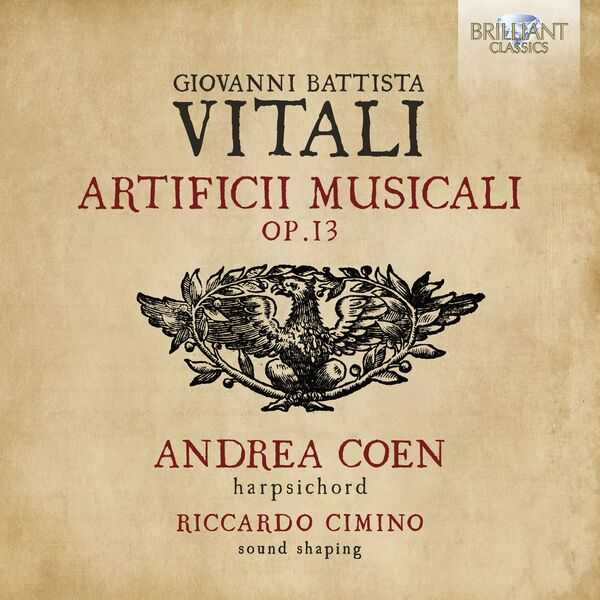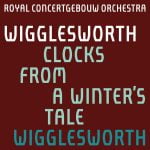

Composer: Giovanni Battista Vitali
Performer: Andrea Coen, Riccardo Cimino
Format: FLAC (tracks)
Label: Brilliant Classics
Catalogue: 96686
Release: 2022
Size: 1.29 GB
Recovery: +3%
Scan: yes
Artificii musicali, Op. 13
01. I. Canone à due alla quinta bassa
02. II. Cantilena à quattro
03. III. Canone à due all’unisono
04. IV. Canone à tre all’unisono
05. V. Canone à tre all’unisono
06. VI. Canone à tre all’unisono
07. VII. Canone à tre all’unisono
08. VIII. Canone à tre all’unisono
09. IX. Canone à tre all’unisono
10. X. Contraria contrariis curantur
11. XI. De minimis non curat praetor
12. XII. Canone à due alti all’vnisono sopra il canto fermo
13. XIII. Canone à tre all’unisono senza nota
14. XIV. Canone à tre all’unisono senza nota
15. XV. Canone à tre
16. XVI. Canone à due alla quarta sotto
17. XVII. Incipies sequeris non errabis
18. XVIII. Canone, nella replica si tralascia il sospiro
19. XIX. Canone
20. XX. Canone à due
21. XXI. Canone à due
22. XXII. Canone alla quinta
23. XXIII. Canone à due all’unisono
24. XXIV. Canone à due all’unisono
25. XXV. Canone à due alla quinta sopra
26. XXVI. Canone alla quinta sotto (a 2)
27. XXVII. Canone à due all’unisono
28. XXVIII. Canone à due all’unisono
29. XXIX. Modulatione cancrizzata à due
30. XXX. Modulatione à due
31. XXXI. Modulatione à due
32. XXXII. Canone (a 2)
33. XXXIII. Canone à quattro
34. XXXIV. Canone à quattro
35. XXXV. Canone à quattro
36. XXXVI. Canone à quattro
37. XXXVII. Canone à quattro
38. XXXVIII. Modulatione (a 4)
39. XXXIX. Canone à quattro all’unisono
40. XL. Canone à quattro all’unisono
41. XLI. Canone à quattro all’unisono
42. XLII. Canone à quattro bassi all’unisono
43. XLIII. Canone à sei soprani all’unisono
44. XLIV. Canone à otto bassi all’unisono
45. XLV. Canone à dieci bassi all’unisono
46. XLVI. Canone à dodeci bassi all’unisono
47. XLVII. Sinfonia à due violini in canone all’vnisono
48. XLVIII. Fuga in contrapunto doppio
49. XLIX. La controscritta fuga in contrapunto doppio riuoltata
50. L. Contrapunto doppio
51. LI. Contrapunto doppio
52. LII. Contrapunto doppio
53. LIII. (Balletto)
54. LIV. (Balletto)
55. LV. Capricio primo
56. LVI. Capricio secondo
57. LVII. Capricio terzo
58. LVIII. Capricio quarto
59. LIX. Passagallo
Prima suonata à violino solo
60. I. Largo
61. II. Allegro
62. III. (Grave)
63. IV. (Allegro)
64. V. (…)
Seconda suonata à violino solo
65. I. Grave
66. II. Prestissimo
67. III. Grave
68. IV. Allegro
69. V. Largo
Born in Bologna on 18 February 1632, Giovanni Battista Vitali (d. 1692) was one of the most outstanding composers of his generation. Rising to become sotto maestro di cappella at the court of the music-loving Duke Francesco II d’Este in 1674, the Italian’s output ranges from cantatas and oratorios to various instrumental works.
The Artificii Musicali Op.13 (1689) is one of the most comprehensive studies of counterpoint before Bach’s Die Kunst der Fuge and Musicalisches Opfer. The sixty pieces are an impressive display of contrapuntal technique for a variety of scorings, arranged in order of increasing difficulty. The collection contains canons for two to twelve voices, many incorporating additional compositional devices (e.g., canon 25. Canon à 2, at the fifth above, which ascends a step on repeating). Vitali also employs similar compositional devices in the non-canonic pieces in the collection – for example, a balletto in three different meters simultaneously, a passacaglia which modulates from E flat major to E major through the cycle of fifths, and another Balletto for two treble instruments which has one line written in G and the other in F.
The present recording is unique in that everything is performed only with one harpsichord, artfully multiplied by working in multitrack and using other sophisticated technological ‘artifices’ in order to do justice to the fascinating and complex nature of this work. For this the artist collaborated with one of the major Italian sound designers, Riccardo Cimino, who, besides being a composer and guitarist, owns a studio equipped with cutting-edge technologies of the highest level, including “ambisonics”.
Andrea Coen is an organist, harpsichordist, and fortepianist, who has studied with such distinguished artists as Ton Koopman and Alan Curtis, and has collaborated with such figures as Christopher Hogwood and Monica Huggett. His recordings of Baroque and early-Classical keyboard repertoire for Brilliant Classics have attracted glowing reviews. Coen recorded the “Kleine Kammermusik” (BC 95683) and made the first complete recording of Telemann’s “100 Menuets” (BC 96249) and Telemann’s Fantasias (94228). According to MusicWeb International: ‘Coen, an experienced, insightful instrumentalist with a profound knowledge of historical performance practice and a sackful of important recordings under his belt, could make Telemann sound special even on a typewriter.’



